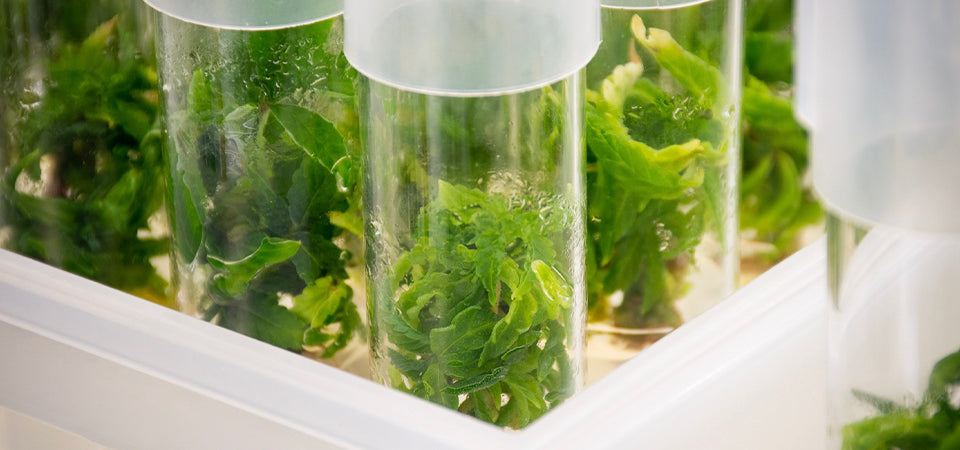Tissue Culture and How it Can Improve My Operation

Cannabis tissue culture is a relatively new propagation method that is revolutionizing the cannabis industry. Tissue culture propagation—also known as micropropagation and microcloning—allows cannabis growers to produce hundreds or even thousands of baby cannabis plants from a single mother plant.
Micropropagation is of interest to solventless extractors as well as growers because it's an excellent way to preserve the plant genetics of strains that offer high yields and aromatic profiles that are ideal for hash and rosin production. Ensuring the best genetics then allows you to produce the highest possible quality extracts for your customers and differentiate yourself in a competitive market.
What Is Cannabis Tissue Culture?
Cannabis tissue culture involves propagating new plants in vitro from very small cuttings taken from a mother plant. Plants contain totipotent cells—similar to human stem cells—that can differentiate themselves as they develop. This makes it possible to grow new plants with very little starting material.
The very tiny amount of plant tissue required to grow a new plant (as little as a single cell) using this cloning method means that thousands of new plants can be grown from one or two mother plants and all in a small space. It's like traditional cloning from cuttings except that the output is multiplied many times over.
How Does Cannabis Tissue Culture Work?
Cannabis sativa tissue culture propagation involves the following steps:
- The tissue culture media is prepared. This media contains the macro-nutrients, micro-nutrients, and plant growth regulators (hormones) the plants need to develop and grow. Once prepared, the media and any tools that will be used are sterilized (for example, using an autoclave). It's essential to maintain a sterile environment to prevent bacteria or fungi from affecting the plants.
- Small cuttings are taken from the mother plant. These cuttings are called “explants.” Leaf, stem, root, petiole, hypocotyl, cotyledon, embryo, or meristem explants can be used.
- The explants are surface-sterilized with alcohol to kill any pathogens.
- The sterilized cuttings are placed on the tissue culture media in test tubes, petri dishes, or flasks.
- The containers are sealed and placed inside a growth room or chamber with controlled conditions (humidity, light, and temperature).
- The plant tissues develop into plantlets.
- Once the plantlets have finished forming, they are transferred to soil or compost and gradually acclimatized to the conditions they will face once they are transplanted.
Benefits of Cannabis Tissue Culture
Tissue culture offers several important benefits for cannabis growers:
Disease-Free Plants

The sterilization process removes viruses and pathogens. This prevents yield losses due to disease, as long as the plants are grown in a controlled environment.
Sterilization also allows you to sell cannabis products that are both disease-free and free from the harmful chemicals that are often used to remediate diseases in plants.
Consistent Yields
Tissue culture creates clones of the mother plant. This means that the new plants will share the same characteristics as the mother plant (and each other) and produce more consistent yields than growing from seed.
Genetic Preservation

Cannabis tissue culture is the best way to preserve your most highly prized strains. Growing cannabis from seed not only comes with the possibility of producing male cannabis plants but also results in genetic variations—just like the genetic variations seen in different children of the same two parents.
Tissue culture, in contrast, creates child plants that are genetically identical. This is a huge advantage if you've produced some of the best strains for bubble hash and rosin and want to ensure consistent extracts and yields in the future.
Year-Round Production
Tissue culture plants can be produced year-round because they are grown in a controlled environment unaffected by season and climate. This ensures uninterrupted cannabis production and streamlines your workflow.
Challenges with Micropropagation
Cannabis tissue culture also comes with a few challenges of which growers should be aware:
- Cost: Tissue culture or micropropagation requires an investment at the outset to set up a sterile propagation lab. It is also fairly labor intensive.
- Expertise: Micropropagation involves a learning curve and it takes time to develop expertise in the techniques used.
- Acclimation/acclimatization: Tissue culture plants are used to the sterile conditions in which they were grown and must be acclimatized before they can be transplanted. This process takes time and must be completed correctly to prevent problems after planting.
- Somaclonal variation: Tissue culture plants can display slight variations or mutations from the mother plant due to damaged DNA or genetic drift over time. The risk of mutations can be reduced by using larger explants (i.e. shoot culture) rather than single cells and reasonable amounts of plant growth regulators for the tissue culture process (see the “Somaclonal Variation” section of the linked video). Any mutated tissue culture plants that do appear can be discarded.
Tissue Culture Is the Future of Cannabis
Cannabis tissue culture offers exciting possibilities for breeders and growers thanks to its ability to produce large numbers of plant clones in a small space. This propagation method requires an investment at the outset but also boosts profits thanks to the more consistent yields and absence of disease.
Solventless extraction professionals can benefit from tissue culture by replicating high-yielding varieties that produce excellent results when washed for bubble hash and pressed for rosin. Experiment with this innovative technique and reap the rewards!



